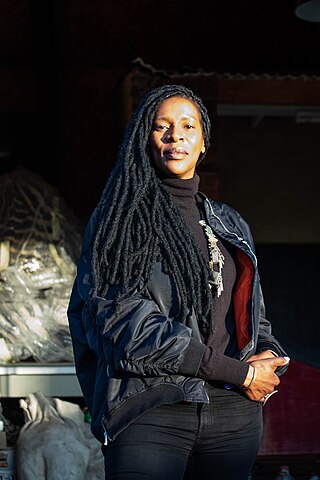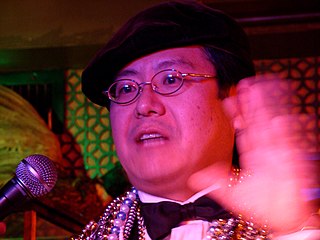Related Research Articles

Taxidermy is the art of preserving an animal's body by mounting or stuffing, for the purpose of display or study. Animals are often, but not always, portrayed in a lifelike state. The word taxidermy describes the process of preserving the animal, but the word is also used to describe the end product, which are called taxidermy mounts or referred to simply as "taxidermy".
The Minneapolis College of Art and Design (MCAD) is a private college specializing in the visual arts and located in Minneapolis, Minnesota. MCAD currently enrolls approximately 800 students. MCAD is one of just a few major art schools to offer a major in comic art.

Mark Parker is an American businessman. He is the executive chairman of Nike, Inc. He was named the third CEO of the company in 2006 and was president and CEO until 13 January 2020. Since April 3, 2023, he has been chairman of The Walt Disney Company.

Angela Singer is an artist of British and New Zealand nationality who lives in Wellington, New Zealand. An animal rights activist, she addresses the way in which people exploit animals and the environment through the repurposing and remodelling of vintage taxidermy, a process she calls "de-taxidermy". Since the 1990s her work has been exhibited both in New Zealand and internationally.

Martha Ann Maxwell was an American naturalist, artist and taxidermist. She helped found modern taxidermy. Maxwell's pioneering diorama displays are said to have influenced major figures in taxidermy history who entered the field later, such as William Temple Hornaday and Carl Akeley. She was born in Pennsylvania in 1831. Among her many accomplishments, she is credited with being the first woman field naturalist to obtain and prepare her own specimens. She was inducted into the Colorado Women's Hall of Fame in 1985.
Walter Potter was an English taxidermist noted for his anthropomorphic dioramas featuring mounted animals mimicking human life, which he displayed at his museum in Bramber, Sussex, England. The exhibition was a well-known and popular example of "Victorian whimsy" for many years, even after Potter's death; however, enthusiasm for such entertainments waned in the twentieth century, and his collection was finally dispersed in 2003.
Kinji Akagawa is an American sculptor, printmaker, and arts educator best known for sculptural constructions that also serve a practical function. A pioneer in the public art movement, Akagawa has throughout his career examined the relationship between art and community, most notably the concept of art as a process of inquiry. His sculpture and public artworks are noted for their refined elegance and use of natural materials, such as granite, basalt, field stone, cedar, and ipe wood.

Taxidermy, or the process of preserving animal skin together with its feathers, fur, or scales, is an art whose existence has been short compared to forms such as painting, sculpture, and music. The word derives from two Greek words: taxis, meaning order, preparation, and arrangement and derma, meaning skin. Directly translated, taxidermy means "skin art."
Lisa Black is a sculpture artist and jeweller based in Auckland, New Zealand. Her work often combines taxidermied animals and preserved insects with found metal and sometimes working mechanical parts, and has been described as "Steampunk" art, although she does not use the term herself. She self categorizes her work by adding "Fixed" to the titles of her pieces made to look living, and "Departed" to the pieces made to look deceased. The first work in the Fixed series was Fixed Fawn. Her work has been featured in Marie Claire Magazine, The New Zealand Herald, and the television show New Zealand's Next Top Model.

Nandipha Mntambo is a South African artist who has become famous for her sculptures, videos and photographs that focus on human female body and identity by using natural, organic materials. Her art style has been self described as eclectic and androgynous. She is best known for her cowhide sculptures that connects the human form to nature.

Takeshi Yamada is a Japanese-American artist and rogue taxidermist.
Polly Morgan is a London-based British artist who uses taxidermy to create works of art.
Harriet Bart is a Minneapolis-based conceptual artist, known for her objects, installations, and artists books.
Jody Williams is an American artist, writer, and teacher. She creates and publishes artist's books under the imprint Flying Paper Press in her studio in Minneapolis, Minnesota. She works in a range of media, including artist's books, collages, drawings, etchings, bronze sculptures, and mixed-media boxes that she calls not-empty boxes.
The conservation and restoration of fur objects is the preservation and protection of objects made from or containing fur. These pieces can include personal items like fur clothing or objects of cultural heritage that are housed in museums and collections. When dealing with the latter, a conservator-restorer often handles their care, whereas, for the public, professional furriers can be found in many neighborhoods.
Angela Strassheim is an American photographer living and working in Brooklyn, New York and Jerusalem. Prior to receiving her MFA from Yale in 2003, Strassheim worked as a certified forensic photographer. In this capacity she produced crime scene, evidence, and surveillance photography in Miami. Later, having moved to New York, she began to photograph autopsies as well.
Maria Cristina Tavera ("Tina") is a contemporary Latino artist, curator, and cultural organizer who lives and works in Minneapolis, MN. Influenced by her dual citizenship, as well as her transnational movement between her residing Minnesota and Mexico families, she combines historical and contemporary texts and images from recognizable Latin American myths, legends, and present news. Tavera uses her prints, paintings, installations, and Dia de los Muertos ofrendas, or altars, to explore the way that national and cultural icons symbolize complex identities and can construct shared communities at home and abroad. Her artwork is both humorous and confrontational as she invites her viewers to question constructs of race, gender, ethnicity and national and cultural identities. She has exhibited her artwork and curated shows all around the world, and has artworks permanently installed in several art exhibits throughout Minnesota.

Julia deVille is a New Zealand-born artist, jeweller and taxidermist, who only uses subjects in her taxidermy that have died of natural causes. She lives and works in Australia.
Julie Buffalohead is a contemporary Indigenous American artist. Her work mainly focuses on themes of racial injustice, indigenous rights, and abuse of power.

James Arnold Dickinson, MBE, is a British conservation-restoration taxidermist who repaired mounted animal skins and skeletons for museums in the United Kingdom for 40 years. Among his restoration works are the Leeds Irish elk, the Leeds polar bear, the Armley Hippo, and the Warrington seal.
References
- 1 2 3 4 Evans, Hayley (22 February 2016). "Rogue Taxidermy Artists Who Create Imaginative Sculptures". www.illusion.scene360.com. Scene 360 LLC. Retrieved 28 January 2016.
- 1 2 3 4 5 6 Rivera, Erica (8 April 2016). "Crave Profile: Sarina Brewer and Rogue Taxidermy". CraveOnline. CraveOnlineLLC. Archived from the original on 23 July 2018. Retrieved 3 November 2016.
- 1 2 3 Niittynen, Miranda (2015). "Animal Magic; Sculpting Queer Encounters through Rogue Taxidermy Art" (PDF). Gender Forum: Internet Journal for Gender Studies. 55: pp.14-34. ISSN 1613-1878 . Retrieved 3 December 2016.
- 1 2 3 Lundy, Patricia (16 February 2016). "The Renaissance of Handcrafts and Fine Arts Celebrates Dark Culture". Dirge magazine. Archived from the original on 2 October 2017. Retrieved 3 November 2016.
- 1 2 Hilary Simmons (2008). Metamorphosis II: Fifty Contemporary Surreal, Fantastic and Visionary Artists. beinArt Publishing. p. 39. ISBN 978-0-9803231-1-5.
- ↑ "Sarina Brewer - Biography". AskArt. Retrieved 11 June 2021.
- 1 2 DeSmith, Christy (Feb–Mar 2009). "Body of Work". BUST. p. 53: Debbie Stoller and Laurie Henzel. Retrieved 7 March 2017.
{{cite magazine}}: CS1 maint: location (link) - ↑ "Brewer Defines the Art of Rogue Taxidermy MCAD". www.MCAD.edu. Minneapolis College of Art and Design. Archived from the original on 30 November 2017. Retrieved 17 April 2018.
{{cite web}}: CS1 maint: bot: original URL status unknown (link) - 1 2 3 4 5 6 Butzler, Jeanie (12 September 2013), Animal Skins; Visual Surfaces, exhibition catalog: University of Wisconsin–Eau Claire, p. 29
- ↑ Jan Harold Brunvand, PhD (2015). Hearsay; Artists Reveal Urban Legends. p.51: Grand Central Press. p. 51. ISBN 978-0935314939.
{{cite book}}: CS1 maint: location (link) - 1 2 3 4 5 6 Ode, Kim (15 October 2014). "Rogue taxidermy, at the crossroads of art and wildlife". Variety section. Star Tribune . Retrieved 3 November 2016.
- 1 2 3 4 Skinner, Quinton (15 October 2014). "Artist Sarina Brewer Expresses Herself Through Taxidermy". Lifestyle: People & Profiles. Minnesota Monthly Magazine. Retrieved 2 November 2016– via MinnesotaMonthly.com.
- ↑ "Sarina Brewer biography". www.lovettsgallery.com. Lovetts Fine Art. Retrieved 21 March 2018.
- 1 2 Gyldenstrom, Freja (17 June 2017). "Morality and Taxidermy in Art". www.culturised.co.uk. Culturized Co. Archived from the original on 3 October 2017. Retrieved 21 March 2018.
{{cite web}}: CS1 maint: bot: original URL status unknown (link) - ↑ Voon, Claire (14 October 2014). "Women Are Dominating the Rogue Taxidermy Scene". Vice . Retrieved 25 October 2016– via vice.com.
- ↑ Chin, Richard (16 October 2014). "Caution: Rogue taxidermy is in season". TwinCities.com (St. Paul Pioneer Press). Retrieved 25 October 2016.
- 1 2 Karsyn, Ally (25 June 2015). "The right stuff: Spirit Lake taxidermist pins down beauty". Life. Sioux City Journal . Retrieved 3 December 2016.
- 1 2 "Animal Dreams at ArtStart". starjournalnow.com (Star Journal). Multi Media Channels. 6 June 2015. Retrieved 25 October 2016.
- ↑ Topcik, Joel (3 January 2005). "Head of Goat, Tail of Fish, More Than a Touch of Weirdness". Art & Design. The New York Times . Retrieved 21 October 2016.
- 1 2 Robert Marbury (23 September 2014). Taxidermy Art. Artisan. p. 7. ISBN 978-1-57965-640-9.
- ↑ Tremonti, Anna Maria (25 October 2017). "Dead Animals into Art". www.cbc.ca. Canadian Broadcasting Corporation. Archived from the original on 26 October 2017. Retrieved 21 March 2018.
{{cite web}}: CS1 maint: bot: original URL status unknown (link) - 1 2 McDonald, Kate (22 April 2016). "Rogue Taxidermy Sculptor Sarina Brewer". Minnesota Original. PBS via Twin Cities Public Television. Retrieved 3 November 2016.
- 1 2 3 Robert Marbury (23 September 2014). Taxidermy Art. Artisan. p. 29. ISBN 978-1-57965-640-9.
- 1 2 3 4 Grey, Jones (30 April 2015). "Artist Interview: Sarina Brewer". Sinical Magazine. Sinical Magazine LLC. Retrieved 2 November 2016.
- ↑ David Carrier; Joachim Pissarro (14 October 2013). Wild Art . Phaidon Press. p. 138. ISBN 978-0-7148-6567-6 . Retrieved 21 November 2016.
- ↑ Binnie, Ronald (2015). "Vile Bodies". Plastik Art & Science Journal (4). ISSN 2101-0323. Archived from the original on 1 August 2018. Retrieved 8 December 2016.
- ↑ Topcik, Joel (14 January 2005). "Still Life With Road Kill". St. Petersburg Times. St. Petersburg, Florida: The Times Publishing Company. p. E1, E3 – via Newspapers.com.
- 1 2 3 Langston, Erica (30 March 2016). "When Taxidermy Goes Rogue". Audubon. National Audubon Society . Retrieved 3 November 2016.
- ↑ Purdy, Anthony; Helen, Gregory (2015). "Present Signs, Dead Things: Indexical Authenticity and Taxidermy's Nonabsent Animal". Configurations. 23 (1): 75. ISSN 1063-1801 . Retrieved 8 December 2016.
- ↑ Alexis Turner (2013). Taxidermy. Thames & Hudson. p. 28. ISBN 978-0-500-51670-6.
- ↑ "The LA Art Show". Gregorio Escalante Fine Arts. Gregorio Escalante Gallery. 27 January 2016. Retrieved 8 December 2016.